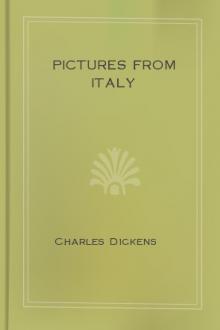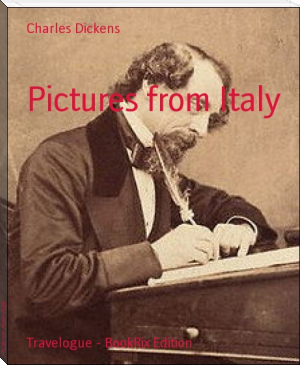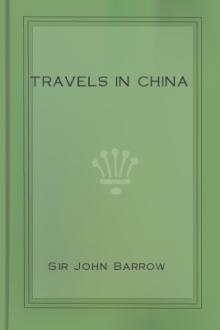Travels Through France And Italy, Tobias Smollett [love novels in english .TXT] 📗

- Author: Tobias Smollett
Book online «Travels Through France And Italy, Tobias Smollett [love novels in english .TXT] 📗». Author Tobias Smollett
Time Was From Noon Till The Evening, When The Romans Ate Their
Principal Meal. Notice Was Given By A Bell, Or Some Such
Instrument, When The Baths Were Opened, As We Learn From Juvenal,
Redde Pilam, Sonat Aes Thermarum, Ludere Pergis?
Virgine Vis Sola Lotus Abdire Domum.
Leave Off; The Bath Bell Rings--What, Still Play On?
Perhaps The Maid In Private Rubs You Down.
There Were Separate Places For The Two Sexes; And Indeed There
Were Baths Opened For The Use Of Women Only, At The Expence Of
Agrippina, The Mother Of Nero, And Some Other Matrons Of The
First Quality. The Use Of Bathing Was Become So Habitual To The
Constitutions Of The Romans, That Galen, In His Book De Sanitate
Tuenda, Mentions A Certain Philosopher, Who, If He Intermitted
But One Day In His Bathing, Was Certainly Attacked With A Fever.
In Order To Preserve Decorum In The Baths, A Set Of Laws And
Regulations Were Published, And The Thermae Were Put Under The
Inspection Of A Censor, Who Was Generally One Of The First
Senators In Rome. Agrippa Left His Gardens And Baths, Which Stood
Near The Pantheon, To The Roman People: Among The Statues That
Adorned Them Was That Of A Youth Naked, As Going Into The Bath,
So Elegantly Formed By The Hand Of Lysippus, That Tiberius, Being
Struck With The Beauty Of It, Ordered It To Be Transferred Into
His Own Palace: But The Populace Raised Such A Clamour Against
Him, That He Was Fain To Have It Reconveyed To Its Former Place.
These Noble Baths Were Restored By Adrian, As We Read In
Spartian; But At Present No Part Of Them Remains.
With Respect To The Present State Of The Old Aqueducts, I Can
Give You Very Little Satisfaction. I Only Saw The Ruins Of That
Which Conveyed The Aqua Claudia, Near The Porta Maggiore, And The
Piazza Of The Lateran. You Know There Were Fourteen Of Those
Antient Aqueducts, Some Of Which Brought Water To Rome From The
Distance Of Forty Miles. The Channels Of Them Were Large Enough
To Admit A Man Armed On Horseback; And Therefore When Rome Was
Part 7 Letter 32 ( Nice, March 10, 1765.) Pg 264To Admit A Man Armed On Horseback; And Therefore When Rome Was
Besieged By The Goths, Who Had Cut Off The Water, Belisarius
Fortified Them With Works To Prevent The Enemy From Entering The
City By Those Conveyances. After That Period, I Suppose The
Antient Aqueducts Continued Dry, And Were Suffered To Run To
Ruins. Without All Doubt, The Romans Were Greatly Obliged To
Those Benefactors, Who Raised Such Stupendous Works For The
Benefit, As Well As The Embellishment Of Their City: But It Might
Have Been Supplied With The Same Water Through Pipes At One
Hundredth Part Of The Expence; And In That Case The Enemy Would
Not Have Found It Such An Easy Matter To Cut It Off. Those Popes
Who Have Provided The Modern City So Plentifully With Excellent
Water, Are Much To Be Commended For The Care And Expence, They
Have Bestowed In Restoring The Streams Called Acqua Virgine,
Acqua Felice, And Acqua Paolina, Which Afford Such Abundance Of
Water As Would Plentifully Supply A Much Larger City Than Modern
Rome.
It Is No Wonder That M. Agrippa, The Son-In-Law, Friend, And
Favourite Of Augustus, Should At The Same Time Have Been The Idol
Of The People, Considering How Surprisingly He Exerted Himself
For The Emolument, Convenience, And Pleasure Of His Fellow-Citizens.
It Was He Who First Conducted This Acqua Virgine To
Rome: He Formed Seven Hundred Reservoirs In The City; Erected One
Hundred And Five Fountains; One Hundred And Thirty Castella, Or
Conduits, Which Works He
Adorned With Three Hundred Statues, And Four Hundred Pillars Of
Marble, In The Space Of One Year. He Also Brought Into Rome, The
Aqua Julia, And Restored The Aqueduct Of The Aqua Marzia, Which
Had Fallen To Decay. I Have Already Observed The Great Number Of
Baths Which He Opened For The People, And The Magnificent
Thermae, With Spacious Gardens, Which He Bequeathed To Them As A
Legacy. But These Benefactions, Great And Munificent As They Seem
To Be, Were Not The Most Important Services He Performed For The
City Of Rome. The Common-Sewers Were First Made By Order Of
Tarquinius Priscus, Not So Much With A View To Cleanliness, As By
Way Of Subterranean Drains To The Velabrum, And In Order To Carry
Off The Stagnant Water, Which Remained In The Lower Parts, After
Heavy Rains. The Different Branches Of These Channels United At
The Forum, From Whence By The Cloaca Maxima, Their Contents Were
Conveyed Into The Tyber. This Great Cloaca Was The Work Of
Tarquinius Superbus. Other Sewers Were Added By Marcus Cato, And
Valerius Flaccus, The Censors. All These Drains Having Been
Choaked Up And Ruinous, Were Cleared And Restored By Marcus
Agrippa, Who Likewise Undermined The Whole City With Canals Of
The Same Kind, For Carrying Of The Filth; He Strengthened And
Enlarged The Cloaca Maxima, So As To Make It Capable Of Receiving
A Large Cart Loaded With Hay; And Directed Seven Streams Of Water
Into These Subterranean Passages, In Order To Keep Them Always
Clean And Open. If, Notwithstanding All These Conveniences,
Vespasian Was Put To Great Expence In Removing The Ordure From
The Public Streets, We Have Certainly A Right To Conclude That
The Antient Romans Were Not More Cleanly Than The Modern
Part 7 Letter 32 ( Nice, March 10, 1765.) Pg 265Italians.
After The Mausolea Of Augustus, And Adrian, Which I Have Already
Mentioned, The Most Remarkable Antient Sepulchres At Rome, Are
Those Of Caius Cestius, And Cecilia Metella. The First, Which
Stands By The Porta Di S. Paolo, Is A Beautiful Pyramid, One
Hundred And Twenty Feet High, Still Preserved Intire, Having A
Vaulted Chamber Within-Side, Adorned With Some Ancient Painting,
Which Is Now Almost Effaced. The Building Is Of Brick, But Eased
With Marble. This Caius Cestius Had Been Consul, Was Very Rich,
And Acted As One Of The Seven Epulones, Who Superintended The
Feasts Of The Gods, Called Lectisternia, And Pervigilia. He
Bequeathed His Whole Fortune To His Friend M. Agrippa, Who Was So
Generous As To Give It Up To The Relations Of The Testator. The
Monument Of Cecilia Metella, Commonly Called Capo Di Bove, Is
Without The Walls On The Via Appia. This Lady Was Daughter Of
Metellus Creticus, And Wife To Crassus, Who Erected This Noble
Monument To Her Memory. It Consisted Of Two Orders, Or Stories,
The First Of Which Was A Square Of Hewn Stone: The Second Was A
Circular Tower, Having A Cornice, Adorned With Ox Heads In Basso
Relievo, A Circumstance From Which It Takes The Name Of Capo Di
Bove. The Ox Was Supposed To Be A Most Grateful Sacrifice To The
Gods. Pliny, Speaking Of Bulls And Oxen, Says,
Hinc Victimae Optimae Et Laudatissima Deorum Placatio.
They Were Accounted The Best Victims And Most Agreeable To
Appease The Anger Of The Gods.
This Tower Was Surmounted By A Noble Cupola Or Dome, Enriched
With All The Ornaments Of Architecture. The Door Of The Building
Was Of Brass; And Within-Side The Ashes Of Cecilia Were Deposited
In A Fluted Marble Urn, Of Curious Workmanship, Which Is Still
Kept In The Palazzo Farnese. At Present The Surface Of The Ground
Is Raised So Much As To Cover The First Order Of The Edifice:
What We See Is No More Than The Round Tower, Without The Dome And
Its Ornaments; And The Following Inscription Still Remains Near
The Top, Facing The Via Appia.
Caecillae
Q. Cretici F.
Metellae
Crassi.
Part 7 Letter 32 ( Nice, March 10, 1765.) Pg 266
To Caecilia Metella, Daughter Of Q. Criticus: Wife Of Crassus.
Now We Are Talking Of Sepulchral Inscriptions, I Shall Conclude
This Letter With The Copy Of A Very Singular Will, Made By
Favonius Jocundus, Who Died In Portugal, By Which Will The
Precise Situation Of The Famous Temple Of Sylvanus Is
Ascertained.
"Jocundi.
Ego Gallus Favonius Jocundus P. Favoni F. Qui Bello Contra
Viriatum Succubui, Jocundum Et Prudentem Filios, E Me Et Quintia
Fabia Conjuge Mea Ortos, Et Bonorum Jocundi Patris Mei, Et Eorum,
Quae Mihi Ipsi Acquisivi Haeredes Relinquo; Hac Tamen Conditione,
Ut Ab Urbe Romana Huc Veniant, Et Ossa Hic Mea, Intra
Quinquennium Exportent, Et Via Latina Condant In Sepulchro, Jussu
Meo Condito, Et Mea Voluntate; In Quo Velim Neminem Mecum, Neque
Servum, Neque Libertum Inseri; Et Velim Ossa Quorumcunque
Sepulchro Statim Meo Eruantur, Et Jura Romanorum Serventur, In
Sepulchris Ritu Majorum Retinendis, Juxta Volantatem Testatoris;
Et Si Secus Fecerint, Nisi Legittimae Oriantur Causae, Velim Ea
Omnia, Quae Filijs Meis Relinquo, Pro Reparando Templo Dei
Sylvani, Quod Sub Viminali Monte Est, Attribui; Manesque Mei A
Pont. Max; A Flaminibus Dialibus, Qui In Capitolio Sunt, Opem
Implorent, Ad Liberorum Meorum Impietatem Ulciscendam;
Teneanturque Sacerdotes Dei Silvani, Me In Urbem Referre, Et
Sepulchro Me Meo Condere. Volo Quoque Vernas Qui Domi Meae Sunt,
Omnes A Praetore Urbano Liberos, Cum Matribus Dimitti,
Singulisque Libram Argenti Puri, Et Vestem Unam Dori. In
Lusitania. In Agro Viii. Cal Quintilis, Bello Viriatino."
I, Gallus Favonius Jocundus, Son Of P. Favonius, Dying In The War
Against Viriatus, Declare My Sons Jocundus And Prudens, By My
Wife Quintia Fabia, Joint Heirs Of My Estate, Real And Personal;
On Condition, However, That They Come Hither Within A Time Of
Five Years From This My Last Will, And Transport My Remains To
Rome To Be Deposited In My Sepulchre Built In The Via Latina By
My Own Order And Direction: And It Is My Will That Neither Slave
Nor Freedman Shall Be Interred With Me In The Said Tomb; That If
Any Such There Be, They Shall Be Removed, And The Roman Law
Obeyed, In Preserving In The Antient Form The Sepulchre According
To The Will Of The Testator. If They Act Otherwise Without Just
Cause, It Is My Will That The Whole Estate, Which I Now Bequeathe
To My Children, Shall Be Applied To The Reparation Of The Temple
Of The God Sylvanus, At The Foot Of Mount Viminalis; And That My
Manes [The Manes Were An Order Of Gods Supposed To Take
Cognisance Of Such Injuries.] I Shall Implore The Assistance Of





Comments (0)